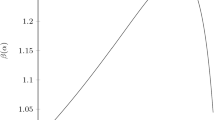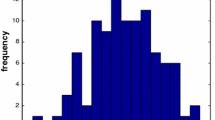Abstract
Models for decision-making under uncertainty use probability distributions to represent variables whose values are unknown when the decisions are to be made. Often the distributions are estimated with observed data. Sometimes these variables depend on the decisions but the dependence is ignored in the decision maker’s model, that is, the decision maker models these variables as having an exogenous probability distribution independent of the decisions, whereas the probability distribution of the variables actually depend on the decisions. It has been shown in the context of revenue management problems that such modeling error can lead to systematic deterioration of decisions as the decision maker attempts to refine the estimates with observed data. Many questions remain to be addressed. Motivated by the revenue management, newsvendor, and a number of other problems, we consider a setting in which the optimal decision for the decision maker’s model is given by a particular quantile of the estimated distribution, and the empirical distribution is used as estimator. We give conditions under which the estimation and control process converges, and show that although in the limit the decision maker’s model appears to be consistent with the observed data, the modeling error can cause the limit decisions to be arbitrarily bad.
Similar content being viewed by others
References
Balakrishnan A, Pangburn M, Stavrulaki E (2004) “Stack them high, let ’em fly”: lot-sizing policies when inventories stimulate demand. Manag Sci 50(5): 630–644
Bassamboo A, Zeevi A (2009) On a data-driven method for staffing large call centers. Oper Res 57 (forthcoming)
Benkherouf L, Boumenir A, Aggoun L (2001) A stochastic inventory model with stock dependent demand items. J Appl Math Stoch Anal 14(4): 317–328
Bertsekas DP, Tsitsiklis JN (1996) Neuro-dynamic programming. Athena Scientific, New York, NY
Besbes O, Zeevi A (2009) Dynamic pricing without knowing the demand function: risk bounds and near-optimal algorithms. Oper Res 57(6): 1407–1420
Besbes O, Phillips R, Zeevi A (2010) Testing the validity of a demand model: an operations perspective. Manuf Serv Oper Manag 12(1): 162–183
Bharadwaj V, Kleywegt AJ (2005) Convergence of derivative-free search algorithms with noisy observations. Technical report, School of Industrial and Systems Engineering, Georgia Institute of Technology, Atlanta, GA 30332-0205
Bharadwaj V, Kleywegt AJ (2008) Derivative free trust region algorithms for stochastic optimization. Technical report, School of Industrial and Systems Engineering, Georgia Institute of Technology, Atlanta, GA 30332-0205
Cachon CP, Kok A (2007) Implementation of the newsvendor model with clearance pricing: how to (and how not to) estimate the salvage value. Manuf Serv Oper Manag 9(3): 276–290
Cooper WL, Homem-de-Mello T, Kleywegt AJ (2006) Models of the spiral down effect in revenue management. Oper Res 54(5): 968–987
Dana JD, Petruzzi NC (2001) Note: the newsvendor model with endogenous demand. Manag Sci 47(11): 1488–1497
Delage E, Ye Y (2010) Distributionally robust optimization under moment uncertainty with application to data-driven problems. Oper Res 58(3): 596–612
Ding X, Puterman ML, Bisi A (2002) The censored newsvendor and the optimal acquisition of information. Oper Res 50(3): 517–527
Giri BC, Pal S, Chaudhuri KS (1996) An inventory model for deteriorating items with stock-dependent demand rate. Eur J Oper Res 95(3): 604–610
Harrison JM, Zeevi A (2005) A method for staffing large call centers based on stochastic fluid models. Manuf Serv Oper Manag 7: 20–36
Homem-de-Mello T (2008) On rates of convergence for stochastic optimization problems under non-i.i.d. sampling. SIAM J Optim 19(2): 524–551
Kleijnen JPC, den Hertog D, Angun E (2004) Response surface methodology’s steepest ascent and step size revisited. Eur J Oper Res 159: 121–131
Kushner HJ, Yin GG (1991) Stochastic approximation, algorithms and applications. Springer, Berlin
Kushner HJ, Yin GG (1997) Stochastic approximation algorithms and applications. Springer, Berlin
Law AM (2007) Simulation modeling and analysis. 4th edn. McGraw-Hill, New York, NY
Levi R, Roundy RO, Shmoys DB (2006) Provably near-optimal sampling-based algorithms for stochastic inventory control models. In: STOC ’06: proceedings of the thirty-eighth annual ACM symposium on theory of computing, pp 739–748, New York, NY, USA. ACM. ISBN: 1-59593-134-1. doi:10.1145/1132516.1132619
Littlewood K (1972) Forecasting and control of passenger bookings. In: AGIFORS 12th annual symposium proceedings, Nathanya, Israel
Liyanage L, Shanthikumar JG (2005) A practical inventory control policy using operational statistics. Oper Res Lett 33: 341–348
Olivares M, Terwiesch C, Cassorla L (2008) Structural estimation of the newsvendor model: an application to reserving operating room time. Manag Sci 54(1): 41–55
Rachev ST, Römisch W (2002) Quantitative stability in stochastic programming: the method of probability metrics. Math Oper Res 27(4): 792–818
Revesz P (1973) Robbins–Monro procedure in a Hilbert space ii. Studia scientiarum mathematicarum Hungarica 8: 469
Römisch W (2003) Stability of stochastic programming problems. In: Ruszczyński A, Shapiro A (eds.) Handbook of stochastic optimization. Elsevier Science Publishers B.V., Amsterdam
Shapiro A, Homem-de-Mello T (2000) On rate of convergence of Monte Carlo approximations of stochastic programs. SIAM J Optim 11: 70–86
Spall JC (2003) Introduction to stochastic search and optimization: estimation, simulation, and control. Wiley, London
Walk H (1977) An invariance principle for the Robbins–Monro in a Hilbert space. Probab Theory Relat Fields 39(2): 135–150
Walk H (1978) Martingales and the Robbins–Monro procedure in D[0,1]. J Mutivar Anal 8: 430–452
Yin R, Aviv Y, Pazgal A, Tang CS (2009) Optimal markdown pricing: implications of inventory display formats in the presence of strategic customers. Manag Sci 55(8): 1391–1408
Author information
Authors and Affiliations
Corresponding author
Electronic Supplementary Material
The Below is the Electronic Supplementary Material.
Rights and permissions
About this article
Cite this article
Lee, S., Homem-de-Mello, T. & Kleywegt, A.J. Newsvendor-type models with decision-dependent uncertainty. Math Meth Oper Res 76, 189–221 (2012). https://doi.org/10.1007/s00186-012-0396-3
Received:
Accepted:
Published:
Issue Date:
DOI: https://doi.org/10.1007/s00186-012-0396-3




